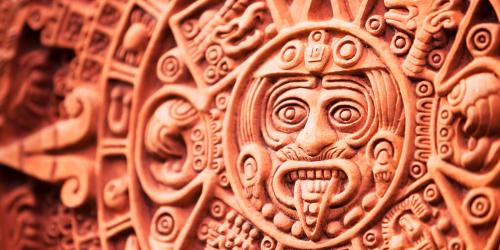You are here
Book of Mormon Central is in the process of migrating to our new Scripture Central website.
We ask for your patience during this transition. Over the coming weeks, all pages of bookofmormoncentral.org will be redirected to their corresponding page on scripturecentral.org, resulting in minimal disruption.

Scripture Block
Mormon 7–9
November 2–8. “I Speak unto You As If Ye Were Present”
Recommended Resources
Learn about the Book of Mormon with verse by verse commentaries from renowned Book of Mormon scholars like John W. Welch and Brant A. Gardner in the ScripturePlus app. Read this week's KnoWhy connected with the Come Follow Me curriculum, and watch a video elucidating an insight in this week's scripture reading.
KnoWhys
Reading Plan
Structure your personal scripture study by following a multimedia, day by day plan. Each day's assignment includes the required scripture passages from the Come Follow Me curriculum, as well as suggestions for additional resources to bring context and understanding to your study.
Monday
- Scripture: Mormon 7:1-10
-
Quote: “Chapter 7 contains the last words that Mormon engraved on the plates, and they are words of testimony concerning Jesus Christ, that he is the Son of God, that he rose again and conquered death, and that he will meet us all at his judgment-seat. He invited the survivors, the Lamanites and their posterity, to lay down their weapons of war, to seek peace and the Prince of Peace. He provides redemption for the world and the opportunity to ‘sing ceaseless praises with the choirs above, unto the Father, and unto the Son, and unto the Holy Ghost . . . in a state of happiness which hath no end.’”
Ogden, D. Kelly, and Andrew C. Skinner. Verse by Verse: the Book of Mormon. Salt Lake City, UT: Deseret Book, 2011. 2:244. -
Quote: “The principle of restoration also means that persons who are not righteous in mortal life will not rise up righteous in the resurrection.... Moreover, unless our mortal sins have been cleansed and blotted out by repentance and forgiveness...we will be resurrected with a ‘bright recollection...’ and a ‘perfect knowledge of all of our guilt, and our uncleanness....’ The seriousness of that reality is emphasized by the many scriptures suggesting that the resurrection is followed immediately by the Final Judgment.”
Oaks, Dallin H. “Resurrection,” General Conference April 2000. -
Quote: “Thus one of the great purposes of continuing revelation through living prophets is to declare to the world through additional witnesses that the Bible is true. “This is written,” an ancient prophet said, speaking of the Book of Mormon, 'for the intent that ye may believe that,' speaking of the Bible. In one of the earliest revelations received by Joseph Smith, the Lord said, 'Behold, I do not bring [the Book of Mormon forth] to destroy [the Bible] but to build it up.'"
Holland, Jeffrey R. “My Words…Never Cease,” General Conference April 2008.
Tuesday
- Scripture: Mormon 8:1-13
- KnoWhy 233: Why Did Moroni Write So Many Farewells?
- KnoWhy 393: How Can the Book of Mormon Survivors Give Us Hope?
Wednesday
- Scripture: Mormon 8:14-32
- KnoWhy 407: Are There Other Ancient Records Like the Book of Mormon?
Thursday
- Scripture: Mormon 8:33-41
-
Quote: “We must make the Book of Mormon a center focus of study because it was written for our day. The Nephites never had the book, neither did the Lamanites of ancient times. It was meant for us. Mormon wrote near the end of the Nephite civilization. Under the inspiration of God, who sees all things from the beginning, he abridged centuries of records, choosing the stories, speeches, and events that would be most helpful to us.... We should constantly ask ourselves...[w]hat lesson can I learn from that to help me live in this day and age?”
Benson, Ezra Taft. The Teachings of Ezra Taft Benson. Salt Lake City, UT: Bookcraft, 1988. 58-59. -
Quote: “As an Apostle of the Lord Jesus Christ, I have traveled the world testifying of Him. I come before you today to bear another witness—a witness to the suffering and need of millions of our Heavenly Father’s children. … They hunger. They ache with cold. They suffer from sickness. They grieve for their children. They mourn for the safety of their families. These people are not strangers and foreigners but children of our Heavenly Father. They are our brothers and our sisters. They are 'fellowcitizens with the saints, and of the household of God.' Their fervent prayers ascend to heaven pleading for respite, for relief from suffering. At this very hour on this very day, some members even in our Church are praying for the miracle that would allow them to surmount the suffering that surrounds them. If, while we have the means to do so, we do not have compassion for them and spring to their aid, we are in danger of being among those the prophet Moroni spoke of when he said, 'Behold, ye do love money, and your substance, and your fine apparel … more than ye love the poor and the needy, the sick and the afflicted.'”
Joseph B. Wirthlin, “The Law of the Fast”, General Conference April 2001. -
Quote: “This prophecy is a solemn warning...to the Latter-day Saints.... The Saints of God need to labor day and night to retain purity of heart and thus propriety in their dealings with God and with one another. Zion can only be established among a people who are pure in heart, a people who search out the poor and needy, who see to those needs, and who focus their attention, their loyalties, and their time on people and on things which have eternal relevance and worth.”
McConkie, Joseph Fielding, and Robert L. Millet. Doctrinal Commentary on the Book of Mormon. Vol. 4. Salt Lake City, UT: Deseret Book, 2002. 250
Friday
- Scripture: Mormon 9:1-14
-
Quote: “Moroni at first evidently intended this chapter to be the last one in the entire Book of Mormon. Thus he addresses himself to ‘those who do not believe in Christ’ (v. 1). Then in a powerful, logical, and forceful manner he outlines the major teachings of the gospel of Jesus Christ and indicates why all men must understand and apply these principles if they are to find the peace and happiness they desire. He says the gospel is not restricted to a chosen few, but is available ‘unto all, even unto the ends of the earth’ (v. 21).”
Ludlow, Daniel H. A Companion to Your Study of the Book of Mormon. Salt Lake City: Deseret Book Co., 1976. 307. -
Quote: “Miracles in our lives are usually the manifestations of the gifts of the Spirit. Sometimes I think we are so used to having them, because the Holy Ghost is so close, that we don’t pay attention to them. Someone said that, ‘a coincidence is a miracle in which God remains anonymous.’ When was the last time you had a really good coincidence happen? Are you having miracles in your life? My impression is that if you are not, it is because you are not recognizing them as such, for one, or because there is a lack of faith. I hope that, for most of us, that second reason is not a possibility. Maybe we need to be paying a little more careful attention.”
Merrill, Bryon R. “Moroni: The Man and the Message (Part 1), 19. -
Quote: “Many believe that revelation ended with the Bible even though the Bible itself is a testimony of God’s revelatory pattern over 4,000 years of man’s existence. But one incorrect doctrine such as this is like a domino set in motion that causes the fall of other dominoes or, in this case, the fall of correct doctrines. A belief in the cessation of revelation causes the doctrine that 'God is the same yesterday, today, and forever' to fall; it causes the doctrine taught by Amos that 'surely the Lord God will do nothing, but he revealeth his secret unto his servants the prophets' to fall; and it causes the doctrine that 'God is no respecter of persons' and thus speaks to all men of all ages to fall. But fortunately the Book of Mormon reenthrones the biblical truth of continuous revelation…In other words, if God, who is unchangeable, spoke in ancient times, He will likewise speak in modern times.”
Tad R. Callister, “The Book of Mormon - a Book from God”, General Conference October 2011
Saturday
- Scripture: Mormon 9:15-31
- KnoWhy 522: Why Does Part of the Long Ending of Mark Show Up in the Book of Mormon?
- KnoWhy 234: Why Did Moroni Conclude His Father’s Record with 22 Commands?
Sunday
- Scripture: Mormon 9:32-37
- KnoWhy 513: Why Did Mormon and Moroni Write in Reformed Egyptian?
- KnoWhy 281: Why is the Book of Mormon So Important to the Restoration?
Additional Resources (Bibliography)
Mormon 7
Mormon 7:3–10
Hatch, Gary Layne. “Mormon and Moroni: Father and Son.” In The Book of Mormon: Fourth Nephi Through Moroni, From Zion to Destruction, edited by Monte S. Nyman and Charles D. Tate, Jr., 105–115. Provo, UT: Religious Studies Center, Brigham Young University, 1995.
Reynolds, Noel B. “’Come unto Me’ as a Technical Gospel Term.” Interpreter: A Journal of Latter-day Saint Faith and Scholarship 31 (2019): 1–24.
Mormon 7:5
Volluz, Corbin T. “O Death, Where Is They Sting?” Insights: A Window on the Ancient World 25, no. 6 (2005): 2–3.
Mormon 7:47
Hinckley, Gordon B. “Mormon Should Mean ‘More Good.’” General Conference October 1990.
Mormon 8
Sperry, Sidney B. “Moroni the Lonely: The Story of the Writing of the Title Page to the Book of Mormon.” Journal of Book of Mormon Studies 4, no. 1 (1995): 255–259.
Thomas, Mark D. “Moroni: The Final Voice.” Journal of Book of Mormon Studies 12, no. 1 (2003): 88–99, 119-120.
Mormon 8:1–3
Book of Mormon Central. “Why Did Moroni Write So Many Farewells? (Mormon 8:1).” KnoWhy 233 (November 17, 2016).
Hales, Brian C. “Dissenters: Portraying the Church as Wrong So They can be Right Without It.” Interpreter: A Journal of Mormon Scripture 10 (2014): 77–121.
Walker, Steve. “Last Words.” In The Reader's Book of Mormon: Last Words: 4 Nephi – Moroni, edited by Robert A. Rees and Eugene England, vii-xxii. Salt Lake City: Signature Books, 2008.
Welch, John W., and Greg Welch. “Who Kept the Records in the Book of Mormon? (By Lineages).” In Charting the Book of Mormon: Visual Aids for Personal Study and Teaching. Provo, UT: Foundation for Ancient Research and Mormon Studies, 1999, chart 17.
Mormon 8:3–8
Book of Mormon Central. “How Can the Book of Mormon Survivors Give Us Hope? (Mormon 8:3).” KnoWhy 393 (December 26, 2017).
Hatch, Gary Layne. “Mormon and Moroni: Father and Son.” In The Book of Mormon: Fourth Nephi Through Moroni, From Zion to Destruction, edited by Monte S. Nyman and Charles D. Tate, Jr., 105–115. Provo, UT: Religious Studies Center, Brigham Young University, 1995.
Petersen, Mark E. “The Last Words of Moroni.” General Conference October 1978.
Mormon 8:16
Book of Mormon Central. “Are There Other Ancient Records Like the Book of Mormon? (Mormon 8:16).” KnoWhy 407 (February 13, 2018).
Mormon 8:23
Welch, John W., and Greg Welch. “Isaiah Passages Listed by Book of Mormon Reference.” In Charting the Book of Mormon: Visual Aids for Personal Study and Teaching. Provo, UT: Foundation for Ancient Research and Mormon Studies, 1999, chart 96.
Welch, John W., and Greg Welch. “Isaiah Passages Listed by Isaiah Reference.” In Charting the Book of Mormon: Visual Aids for Personal Study and Teaching. Provo, UT: Foundation for Ancient Research and Mormon Studies, 1999, chart 97.
Belnap, Daniel. “’We are Not Cut Off’: Separation and Reconciliation through Sacred Covenants.” In Living the Book of Mormon: Abiding by Its Precepts, edited by Gaye Strathearn and Charles Swift, 113–124. Provo, UT/Salt Lake City: Religious Studies Center, Brigham Young University/Deseret Book, 2007.
Mormon 8:28
Bowen, Matthew L. “’See That Ye Are Not Lifted Up’: The Name Zoram and Its Paronomastic Pejoration.” Interpreter: A Journal of Mormon Scripture 19 (2016): 109–143.
Mormon 8:35–37
Petersen, Mark E. “The Last Words of Moroni.” General Conference October 1978.
Bowen, Matthew L. “’See That Ye Are Not Lifted Up’: The Name Zoram and Its Paronomastic Pejoration.” Interpreter: A Journal of Mormon Scripture 19 (2016): 109–143.
Mormon 9
Thomas, Mark D. “Moroni: The Final Voice.” Journal of Book of Mormon Studies 12, no. 1 (2003): 88–99, 119-120.
Van Orden, Bruce A. “Preach the Gospel to Every Creature.” In The Book of Mormon: Fourth Nephi Through Moroni, From Zion to Destruction, edited by Monte S. Nyman and Charles D. Tate, Jr., 323–336. Provo, UT: Religious Studies Center, 1995.
Mormon 9:1–14
Welch, John W., and Greg Welch. “Consistent Elements in Nephite Declarations of Faith.” In Charting the Book of Mormon: Visual Aids for Personal Study and Teaching. Provo, UT: Foundation for Ancient Research and Mormon Studies, 1999, chart 43.
Mormon 9:22–25
Book of Mormon Central. “Why Does Part of the Long Ending of Mark Show Up in the Book of Mormon? (Mormon 9:24).” KnoWhy 522 (June 26, 2019).
Lindsay, Jeff. “The Book of Mormon Versus the Consensus of Scholars: Surprises from the Disputed Longer Ending of Mark, Part 1.” Interpreter: A Journal of Mormon Scripture 25 (2017): 283–321.
Lindsay, Jeff. “The Book of Mormon Versus the Consensus of Scholars: Surprises from the Disputed Longer Ending of Mark, Part 2.” Interpreter: A Journal of Mormon Scripture 25 (2017): 325–365.
Mormon 9:27
Book of Mormon Central. “Why Did Moroni Conclude His Father’s Record with 22 Commands? (Mormon 9:27).” KnoWhy 234 (November 18, 2016).
Mormon 9:30–37
Welch, John W., and Greg Welch. “Who Kept the Records in the Book of Mormon? (Overview).” In Charting the Book of Mormon: Visual Aids for Personal Study and Teaching. Provo, UT: Foundation for Ancient Research and Mormon Studies, 1999, chart 16.
Mormon 9:32–33
Book of Mormon Central. “Why Did Mormon and Moroni Write in Reformed Egyptian? (Mormon 9:32).” KnoWhy 513 (May 2, 2019).
Dale, Bruce E. “How Big A Book? Estimating the Total Surface Area of the Book of Mormon Plates.” Interpreter: A Journal of Mormon Scripture 25 (2017): 261–268.
Gee, John. “Two Notes on Egyptian Script.” In Pressing Forward with the Book of Mormon: The FARMS Updates of the 1990s, edited by John W. Welch and Melvin J. Thorne, 244–247. Provo, UT: FARMS, 1999.
Gee, John. “Epigraphic Considerations on Janne Sjodahl’s Experiment with Nephite Writing.” Journal of Book of Mormon Studies 10, no. 1 (2001): 25, 79.
Hatch, Gary Layne. “Mormon and Moroni: Father and Son.” In The Book of Mormon: Fourth Nephi Through Moroni, From Zion to Destruction, edited by Monte S. Nyman and Charles D. Tate, Jr., 105–115. Provo, UT: Religious Studies Center, Brigham Young University, 1995.
Larsen, David. “Death Being Swallowed Up in Netzach in the Bible and the Book of Mormon.” BYU Studies Quarterly 55, no. 4 (2016): 123–134.
Ricks, Stephen D. “Semitic Texts Written in Egyptian Characters.” In Pressing Forward with the Book of Mormon: The FARMS Updates of the 1990s, edited by John W. Welch and Melvin J. Thorne, 237–243. Provo, UT: FARMS, 1999.
Sjodahl, Janne M. “The Book of Mormon Plates.” Journal of Book of Mormon Studies 10, no. 1 (2001): 22–24, 79.
Smith, Robert F. “The ‘Golden’ Plates.” In Reexploring the Book of Mormon, edited by John W. Welch, 275–278. Provo, UT/Salt Lake City: FARMS/Deseret Book, 1992.
Stubbs, Brian D. “Book of Mormon Language.” In Encyclopedia of Mormonism, Edited by Daniel H. Ludlow. Vol. 1. New York: Macmillan, 1992.
Stubbs, Brian D. “Hebrew and Uto-Aztecan: Possible Linguistic Connections.” In Reexploring the Book of Mormon, edited by John W. Welch, 279–281. Provo, UT/Salt Lake City: FARMS/Deseret Book, 1992.
Tvedtnes, John A. “Reformed Egyptian.” In The Most Correct Book: Insights from a Book of Mormon Scholar, 22–24. Salt Lake City: Cornerstone Publishing, 1999.
Tvedtnes, John A. “Inscribed Gold Plate Fits Book of Mormon Pattern.” Insights: A Window to the Ancient World 28, no. 1 (2008): 3.
Tvedtnes, John A., and Stephen D. Ricks. “Notes and Communications: Jewish and Other Semitic Texts Written in Egyptian Characters.” Journal of Book of Mormon Studies 5, no. 2 (1996): 156–163.
Mormon 9:36
Book of Mormon Central. “Why is the Book of Mormon So Important to the Restoration? (Mormon 9:36).” KnoWhy 281 (March 1, 2017).





